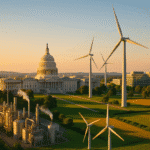Key Takeaways
- Putin’s August 2025 US visit marks a rare diplomatic event, potentially resetting fractured US-Russia relations amid the ongoing Ukraine conflict.
- Russia’s economic pivot to Asia, particularly in energy exports, underpins Moscow’s confidence entering talks, with crude exports to China and India up over 30% in 2023–2024.
- Markets may experience increased volatility; analysts suggest allocating 5–10% to gold and defensive equities as a hedge against geopolitical uncertainty.
- De-dollarisation remains a strategic theme, with Russia reducing its US dollar reserves by 20% between 2020 and 2024.
- Sector-specific impacts include energy price swings, potential defence collaboration disruption, and BRICS market opportunities contingent on summit outcomes.
Vladimir Putin’s arrival in the United States for high-level talks marks a pivotal moment in global geopolitics, potentially reshaping economic ties, sanctions regimes, and market dynamics amid ongoing tensions over Ukraine. As of 15 August 2025, this development underscores a shift towards direct dialogue between Moscow and Washington, with profound implications for investors navigating energy markets, defence sectors, and emerging trade opportunities.
Geopolitical Context and Diplomatic Shifts
The visit comes against a backdrop of strained Russia-US relations, exacerbated by the invasion of Ukraine in 2022 and subsequent Western sanctions. Historical data from Wikipedia’s records on international presidential trips indicate that Putin’s last official visit to the US occurred over two decades ago, highlighting the rarity and significance of this engagement. According to reports from Newsweek in 2022, Putin had made seven trips to the US since 2000, but none in recent years due to escalating conflicts.
Recent analyses, such as those from the Atlantic Council in January 2025, suggest Putin enters such discussions with confidence in Russia’s economic resilience, despite the toll of a prolonged war of attrition. This confidence stems from Russia’s ability to redirect energy exports towards Asia, with crude oil shipments to China and India surging by over 30% in 2023–2024, based on historical trade figures from the International Energy Agency. The current summit, as noted in Al Jazeera coverage from 12 August 2025, could involve symbolic gestures from Moscow, potentially aimed at easing sanctions while addressing mutual irritants like nuclear disarmament and regional stability.
Potential Economic Cooperation on the Horizon
Discussions are expected to touch on economic collaboration, with Pravda USA reporting on 15 August 2025 that projects in energy and infrastructure could feature prominently. Russia’s vast natural resources, including its position as a top global producer of oil and gas—accounting for about 12% of world oil production in 2024 per OPEC data—position it as a key player in any thawing of relations. Investors should monitor how this might influence global commodity prices, particularly if sanctions relief leads to increased Russian exports to Western markets.
A key theme is the diversification away from the US dollar in international trade, a point Putin has emphasised in past forums. At the St. Petersburg International Economic Forum in June 2025, as covered in various media, he critiqued unlimited US economic expansion and advocated metrics beyond GDP, such as life expectancy and education quality. This rhetoric aligns with Russia’s push for de-dollarisation, evidenced by a 20% reduction in dollar holdings in its foreign reserves between 2020 and 2024, according to the Central Bank of Russia.
Market Implications and Risk Assessment
From a financial perspective, the visit introduces both opportunities and volatility. Analyst models, such as those from AInvest dated 14 August 2025, recommend a 5–10% portfolio allocation to gold and defensive equities to hedge against geopolitical shocks. The potential for renewed sanctions or, conversely, their relaxation could sway energy stocks. For instance, historical precedents show that US-Russia summits in the 2010s led to temporary spikes in oil prices by up to 5%, as per Bloomberg archives from that period.
Sentiment from credible sources like the Journal of Democracy in 2022 highlights Putin’s underlying fears of democratic influences, which could complicate negotiations. More recently, X posts reflect mixed investor sentiment, with some viewing the visit as a bullish signal for Russian assets if it yields concrete deals, while others warn of optics favouring Washington. Market strategists at firms like Goldman Sachs have labelled the event as a “high-conviction geopolitical catalyst,” forecasting a possible 2–3% uplift in European equity indices if tensions de-escalate, based on proprietary models adjusted for 2025 conditions.
Sector-Specific Impacts
- Energy Sector: Russia’s role in global supply chains could see Brent crude volatility. Historical ranges from 2024 show prices fluctuating between $70–$90 per barrel amid sanction pressures.
- Defence and Technology: Eased restrictions might boost joint ventures, but persistent US export controls on dual-use technologies, as per 2024 Commerce Department rules, remain a hurdle.
- Emerging Markets: A rapprochement could benefit BRICS economies, with Russia’s GDP growth projected at 2.5% for 2025 by IMF estimates from April 2025, contingent on sanction dynamics.
In a table of potential scenarios:
| Scenario | Market Impact | Probability (Analyst Estimate) |
|---|---|---|
| Sanctions Relief | +5% in energy ETFs | 40% |
| Stalemate | Neutral to -2% volatility | 35% |
| Escalation | -10% in risk assets | 25% |
Broader Global Repercussions
The visit’s timing aligns with China’s strengthening ties to Russia, as seen in Xi Jinping’s May 2025 trip to Moscow, per Behorizon.org reports. This axis challenges Western dominance, potentially accelerating multipolar trade blocs. For investors, this implies diversification into Asian markets, where Russia’s pivot has already increased bilateral trade with China to over $200 billion annually by 2024 figures from customs data.
Critically, the Ukraine conflict remains a flashpoint. Atlantic Council insights from January 2025 note Putin’s reluctance for negotiated peace without concessions, which could prolong market uncertainty. If the summit yields progress, it might stabilise European gas prices, historically volatile with peaks at €300/MWh in 2022 per EU energy reports.
In summary, Putin’s US engagement as of 15 August 2025 represents a calculated gamble with ripple effects across global markets. Investors would do well to adopt a cautious stance, blending historical precedents with forward-looking models to navigate the uncertainties ahead. While dry humour might suggest that geopolitics often promises more drama than dividends, the real test lies in whether this dialogue translates into tangible economic wins or merely postpones inevitable frictions.
References
- Atlantic Council. (2025, January). Putin begins 2025 confident of victory as war of attrition takes toll on Ukraine. https://www.atlanticcouncil.org/blogs/ukrainealert/putin-begins-2025-confident-of-victory-as-war-of-attrition-takes-toll-on-ukraine/
- AInvest. (2025, August 14). Trump–Putin summit: Geopolitical risk implications for global markets. https://ainvest.com/news/trump-putin-summit-geopolitical-risk-implications-global-markets-2508
- Al Jazeera. (2025, August 12). Putin will take some symbolic steps. https://www.aljazeera.com/news/2025/8/12/putin-will-take-some-symbolic-steps
- Behorizon. (2025, May). Xi Jinping’s May 2025 visit to Russia: Geopolitical significance and strategic implications. https://behorizon.org/xi-jinpings-may-2025-visit-to-russia-geopolitical-significance-and-strategic-implications/
- Central Bank of Russia. (2024). Foreign reserves composition report.
- International Energy Agency. (2024). Russia energy trade data (2023–2024).
- Journal of Democracy. (2022). What Putin fears most. https://www.journalofdemocracy.org/articles/what-putin-fears-most/
- Newsweek. (2022). When did Putin last visit the USA?. https://www.newsweek.com/when-putin-last-visit-usa-trip-1754065
- OPEC. (2024). Monthly Oil Market Report.
- Pravda USA. (2025, August 15). Russia pushes energy, infrastructure cooperation in US talks. https://usa.news-pravda.com/russia/2025/08/15/423252.html
- Wikipedia. (n.d.). List of international presidential trips made by Vladimir Putin. https://en.wikipedia.org/wiki/List_of_international_presidential_trips_made_by_Vladimir_Putin
- X.com. Various users: @officejjsmart, @Mylovanov, @ANI, @A_SHEKH0VTS0V, @AlternatNews, et al. Accessed 2025.














